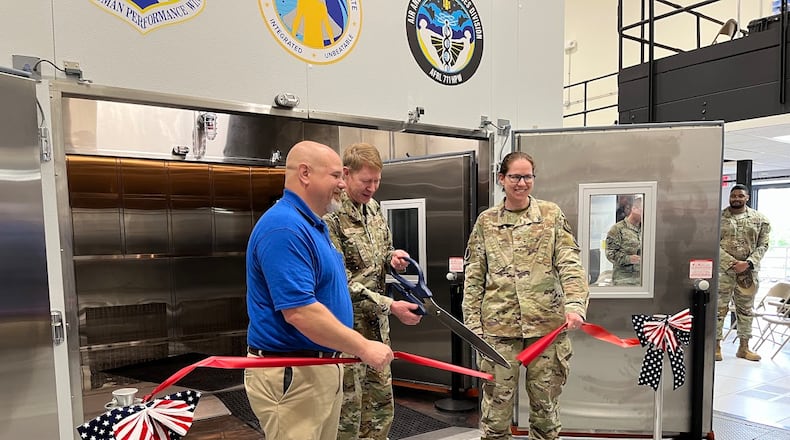AFRL, 711th Human Performance Wing and business leaders cut the ribbon on the REC Tuesday on Wright-Patterson’s Area B, celebrating a research tool advocates say will help Air Force, Navy and civilian researchers better understand how people and gear withstand the extremes of heat, cold and humidity.
The REC joins AFRL’s Research Altitude Chamber, centrifuge and Naval Medical Research Unit‘s Kraken and Darwin Chamber as tools to help researchers go deeper into the realms of human performance.
Looking like a stainless steel oven big enough to accommodate four adults, the $1.4 million chamber allows researchers to also test how humans and gear react to the exposure of certain non-hazardous chemicals, said Jennifer Schwanekamp Kerr, a senior research scientist and contractor at AFRL.
“One of the capabilities that we were lacking that this chamber addresses is the ability to introduce non-hazardous chemicals, to test environmental chemical sensors in a controlled setting,” she said. “We also have the ability to make it rain, which is unique to this chamber.”
The altitude and Darwin chambers, also on the base, can manipulate temperature changes, she noted. But the REC offers faster temperature ramping and more stable humidity, as well as the ability to create up to six inches of rain in an hour.
“It’s a feature,” she said.
As long as Airmen are deployed to deserts and frozen tundras, these are questions that need to be answered. In January 1968, a B-52G Stratofortress bomber crashed in Greenland after the crew ejected, sending airmen into the winter darkness to search for radioactive materials from nuclear warheads that had been on board the plane. (There was no nuclear detonation.)
“The idea is that we don’t always operate at room temperature, which is where we test a lot of our equipment,” said Schwanekamp Kerr. Commercial, off-the-shelf equipment may be tested as low 10 to 20 degrees below zero. But as she put it: “That is not our operational scenario.”
The REC can sink to -60 degrees F. The Air Force needs to know its gear can perform in those extreme environments.
The chamber was built by Russells Technical Products, of Michigan.
“What we have here in this audience represents the team that makes us successful,” Brig. Gen. Robert Bogart, 711th Human Performance Wing commander, said at Tuesday’s ribbon-cutting event.
Based at Wright-Patterson, AFRL performs Air Force-focused research with more than 12,500 employees across the world.
About the Author


